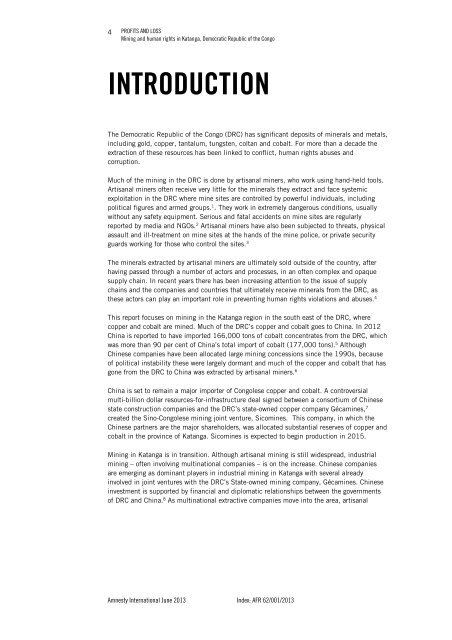Download - Amnesty International Canada
Download - Amnesty International Canada
Download - Amnesty International Canada
Create successful ePaper yourself
Turn your PDF publications into a flip-book with our unique Google optimized e-Paper software.
4<br />
PROFITS AND LOSS<br />
Mining and human rights in Katanga, Democratic Republic of the Congo<br />
INTRODUCTION<br />
The Democratic Republic of the Congo (DRC) has significant deposits of minerals and metals,<br />
including gold, copper, tantalum, tungsten, coltan and cobalt. For more than a decade the<br />
extraction of these resources has been linked to conflict, human rights abuses and<br />
corruption.<br />
Much of the mining in the DRC is done by artisanal miners, who work using hand-held tools.<br />
Artisanal miners often receive very little for the minerals they extract and face systemic<br />
exploitation in the DRC where mine sites are controlled by powerful individuals, including<br />
political figures and armed groups. 1 . They work in extremely dangerous conditions, usually<br />
without any safety equipment. Serious and fatal accidents on mine sites are regularly<br />
reported by media and NGOs. 2 Artisanal miners have also been subjected to threats, physical<br />
assault and ill-treatment on mine sites at the hands of the mine police, or private security<br />
guards working for those who control the sites. 3<br />
The minerals extracted by artisanal miners are ultimately sold outside of the country, after<br />
having passed through a number of actors and processes, in an often complex and opaque<br />
supply chain. In recent years there has been increasing attention to the issue of supply<br />
chains and the companies and countries that ultimately receive minerals from the DRC, as<br />
these actors can play an important role in preventing human rights violations and abuses. 4<br />
This report focuses on mining in the Katanga region in the south east of the DRC, where<br />
copper and cobalt are mined. Much of the DRC’s copper and cobalt goes to China. In 2012<br />
China is reported to have imported 166,000 tons of cobalt concentrates from the DRC, which<br />
was more than 90 per cent of China’s total import of cobalt (177,000 tons). 5 Although<br />
Chinese companies have been allocated large mining concessions since the 1990s, because<br />
of political instability these were largely dormant and much of the copper and cobalt that has<br />
gone from the DRC to China was extracted by artisanal miners. 6<br />
China is set to remain a major importer of Congolese copper and cobalt. A controversial<br />
multi-billion dollar resources-for-infrastructure deal signed between a consortium of Chinese<br />
state construction companies and the DRC’s state-owned copper company Gécamines, 7<br />
created the Sino-Congolese mining joint venture, Sicomines. This company, in which the<br />
Chinese partners are the major shareholders, was allocated substantial reserves of copper and<br />
cobalt in the province of Katanga. Sicomines is expected to begin production in 2015.<br />
Mining in Katanga is in transition. Although artisanal mining is still widespread, industrial<br />
mining – often involving multinational companies – is on the increase. Chinese companies<br />
are emerging as dominant players in industrial mining in Katanga with several already<br />
involved in joint ventures with the DRC’s State-owned mining company, Gécamines. Chinese<br />
investment is supported by financial and diplomatic relationships between the governments<br />
of DRC and China. 8 As multinational extractive companies move into the area, artisanal<br />
<strong>Amnesty</strong> <strong>International</strong> June 2013 Index: AFR 62/001/2013


